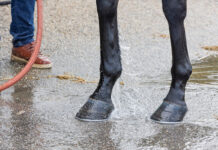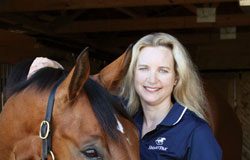
A: Known as “kissing spines” by horsemen and “overriding dorsal spinous processes” by veterinarians, in clearest terms the condition is spinal processes along the horse’s back that touch or “kiss” one another at rest or in motion. Although “kissing spines” generally occur at or behind the saddle area, the withers are an excellent example of these spinal processes, being long thin bones that protrude upward from each vertebrae.
While some cases are due to a fall or other injury, many times the conformation of the vertebrae themselves (narrow interspinal spaces) are to blame for the impingement. Spinal processes that rub together are not only painful to the horse, they create additional lesions such as bony remodeling and ligament inflammation.
According to Jean-Marie Denoix, DVM, PhD, an expert in equine biomechanics, “kissing spines” occurs most often in young thoroughbreds or thoroughbred-crosses with short backs used primarily for jumping. Show jumpers appear to be the most commonly affected, although eventers and hunters suffer from this condition as well.
While some horses with “kissing spines” show clear signs of back pain, many don’t, and diagnosis can be a challenge. Other signs pointing to this condition include back stiffness, reduced jumping ability, resistance to work, change of temperament, resentment of grooming or picking up the hind feet. Horses with “kissing spines” may also be reluctant to lie down or roll. Imaging techniques such as radiography (x-rays), nuclear scintigraphy (bone scan), or ultrasound are necessary to rule in “kissing spines” and rule out other causes of back pain.
Once an impingement is diagnosed, rest may be prescribed along with medical treatment and physical therapy. Medical treatment may include local injection of steroids into the interspinal spaces, NSAIDs such as phenylbutazone, as well as mesotherapy, a pain-dampening technique that stimulates the mesoderm, the middle layer of the skin. Options for physical therapy range from magnets and massage to acupuncture and chiropractic to swimming and shockwave therapy.
Thoughtful rehabilitative exercise is gradually introduced through handwalking, lunging, then riding, being careful to avoid any activity that seems painful to the horse while building and strengthening the muscles and ligaments of the back. Saddle fit and rider balance is extremely critical to the success of recovery and in preventing recurrence of the condition.
Although many horses do well with a combination of rest, medical management and physical therapy, the clinical signs often return. This may mean decreasing the horse’s level of performance to avoid jarring the spinal processes together or, in severe cases, performing surgery to remove one or more of the processes.






